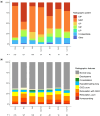Lung imaging patterns in connective tissue disease-associated interstitial lung disease impact prognosis and immunosuppression response
- PMID: 38336872
- PMCID: PMC11443038
- DOI: 10.1093/rheumatology/keae076
Lung imaging patterns in connective tissue disease-associated interstitial lung disease impact prognosis and immunosuppression response
Abstract
Objectives: Interstitial lung disease (ILD) in CTDs has highly variable morphology. We aimed to identify imaging features and their impact on ILD progression, mortality, and immunosuppression response.
Methods: Patients with CTD-ILD had high-resolution chest CT (HRCT) reviewed by expert radiologists blinded to clinical data for overall imaging pattern [usual interstitial pneumonia (UIP); non-specific interstitial pneumonia (NSIP); organizing pneumonia (OP); fibrotic hypersensitivity pneumonitis (fHP); and other]. Transplant-free survival and change in percent-predicted forced vital capacity (FVC) were compared using Cox and linear mixed-effects models adjusted for age, sex, smoking, and baseline FVC. FVC decline after immunosuppression was compared with pre-treatment.
Results: Among 645 CTD-ILD patients, the most frequent CTDs were SSc (n = 215), RA (n = 127), and inflammatory myopathies (n = 100). NSIP was the most common pattern (54%), followed by UIP (20%), fHP (9%), and OP (5%). Compared with the case for patients with UIP, FVC decline was slower in patients with NSIP (by 1.1%/year, 95% CI 0.2, 1.9) or OP (by 3.5%/year, 95% CI 2.0, 4.9), and mortality was lower in patients with NSIP [hazard ratio (HR) 0.65, 95% CI 0.45, 0.93] or OP (HR 0.18, 95% CI 0.05, 0.57), but higher in fHP (HR 1.58, 95% CI 1.01, 2.40). The extent of fibrosis also predicted FVC decline and mortality. After immunosuppression, FVC decline was slower compared with pre-treatment in NSIP (by 2.1%/year, 95% CI 1.4, 2.8), with no change for UIP or fHP.
Conclusion: Multiple radiologic patterns are possible in CTD-ILD, including a fHP pattern. NSIP and OP were associated with better outcomes and response to immunosuppression, while fHP had worse survival compared with UIP.
Keywords: connective tissue disease; interstitial lung disease; prognosis; radiologic patterns.
© The Author(s) 2024. Published by Oxford University Press on behalf of the British Society for Rheumatology. All rights reserved. For permissions, please email: journals.permissions@oup.com.
Figures




References
-
- Marinescu D-C, Hague CJ, Muller NL et al. Integration and application of radiologic patterns from clinical practice guidelines on idiopathic pulmonary fibrosis and fibrotic hypersensitivity pneumonitis. CHEST 2023;164:1466–75. - PubMed
MeSH terms
Substances
Grants and funding
LinkOut - more resources
Full Text Sources
Medical
Molecular Biology Databases
Miscellaneous

